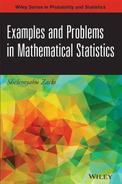Preface
I have been teaching probability and mathematical statistics to graduate students for close to 50 years. In my career I realized that the most difficult task for students is solving problems. Bright students can generally grasp the theory easier than apply it. In order to overcome this hurdle, I used to write examples of solutions to problems and hand it to my students. I often wrote examples for the students based on my published research. Over the years I have accumulated a large number of such examples and problems. This book is aimed at sharing these examples and problems with the population of students, researchers, and teachers.
The book consists of nine chapters. Each chapter has four parts. The first part contains a short presentation of the theory. This is required especially for establishing notation and to provide a quick overview of the important results and references. The second part consists of examples. The examples follow the theoretical presentation. The third part consists of problems for solution, arranged by the corresponding sections of the theory part. The fourth part presents solutions to some selected problems. The solutions are generally not as detailed as the examples, but as such these are examples of solutions. I tried to demonstrate how to apply known results in order to solve problems elegantly. All together there are in the book 167 examples and 431 problems.
The emphasis in the book is on statistical inference. The first chapter on probability is especially important for students who have not had a course on advanced probability. Chapter Two is on the theory of distribution functions. This is basic to all developments in the book, and from my experience, it is important for all students to master this calculus of distributions. The chapter covers multivariate distributions, especially the multivariate normal; conditional distributions; techniques of determining variances and covariances of sample moments; the theory of exponential families; Edgeworth expansions and saddle–point approximations; and more. Chapter Three covers the theory of sufficient statistics, completeness of families of distributions, and the information in samples. In particular, it presents the Fisher information, the Kullback–Leibler information, and the Hellinger distance. Chapter Four provides a strong foundation in the theory of testing statistical hypotheses. The Wald SPRT is discussed there too. Chapter Five is focused on optimal point estimation of different kinds. Pitman estimators and equivariant estimators are also discussed. Chapter Six covers problems of efficient confidence intervals, in particular the problem of determining fixed–width confidence intervals by two–stage or sequential sampling. Chapter Seven covers techniques of large sample approximations, useful in estimation and testing. Chapter Eight is devoted to Bayesian analysis, including empirical Bayes theory. It highlights computational approximations by numerical analysis and simulations. Finally, Chapter Nine presents a few more advanced topics, such as minimaxity, admissibility, structural distributions, and the Stein–type estimators.
I would like to acknowledge with gratitude the contributions of my many ex–students, who toiled through these examples and problems and gave me their important feedback. In particular, I am very grateful and indebted to my colleagues, Professors A. Schick, Q. Yu, S. De, and A. Polunchenko, who carefully read parts of this book and provided important comments. Mrs. Marge Pratt skillfully typed several drafts of this book with patience and grace. To her I extend my heartfelt thanks. Finally, I would like to thank my wife Hanna for giving me the conditions and encouragement to do research and engage in scholarly writing.
SHELEMYAHU ZACKS
